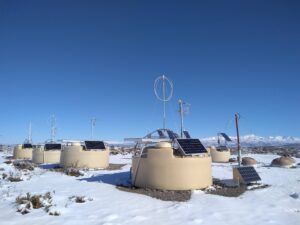The Pierre Auger Observatory for cosmic rays in Argentina is making some of its measurements and initial analyses accessible to the general public. The open data are intended for educational purposes and amateur scientists, but also for other scientists.
The Netherlands has traditionally been a partner in the Auger project in South America, mainly through the Nikhef group in Nijmegen. Auger is spread over 3000 square kilometers in the pampa of Argentina and measures the arrival of cosmic particles in the earth’s atmosphere with detectors, fluorescence telescopes and antennas. From the scattered signals, traces of particles and possible sources can be reconstructed.

Measurements have shown that sometimes unprecedented energetic particles land on Earth in the process. The sources of these particles are still an astrophysical mystery.
A good portion of Auger’s data has been accessible since today via the website www.auger.org/opendata/. According to Auger, the openness is a way to reach a more diverse group of users of scientific data. This increases the scientific potential for the future, the announcement said today.
Auger has long had a policy of open data, and publicly accessible publications without publishers’ pay walls. In 2007, one percent of data was made public, and in 2019 at the observatory’s 20th anniversary, ten percent. Now, ten percent of the really raw measurement data is also becoming public plus its analyses by Auger scientists.
Ten percent of the measurements is more than enough for educational purposes, but it does not provide the statistical acuity of a full dataset. Auger’s early publications, which first found superenergic traces, did have about the same reliability.
Open data policies have also been a trend in particle physics in recent years. Late last year, particle lab CERN in Geneva also decided to be open about a significant part of the measurements around the LHC accelerator. In the Netherlands, research financier NWO demands maximum openness of research paid for with public money. Many publications by Nikhef groups are already open-access for this reason.